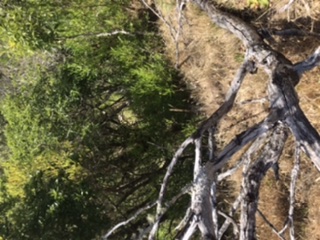Everyone has pretty much covered it - the steeper the angle, the less drop you have. If you were aiming for the chest then the shot going into the jaw isn’t a result of the angle though, that is just a result of how well you shot in that uphill position which can be tricky.
Welcome guest, is this your first visit? Create Account now to join.
Welcome to the NZ Hunting and Shooting Forums.
Search Forums
User Tag List
+ Reply to Thread
Results 16 to 30 of 30
Thread: Incline / decline shooting
-
15-02-2024, 09:56 PM #16
-
-
16-02-2024, 07:19 AM #17Member

- Join Date
- Feb 2024
- Location
- Hokitika
- Posts
- 110
I would have to disagree, i had a great rest with bipod and no pressure as animal was standing front on and still , distance was fine,
i aimed right in the brisket- shot felt good but went high- first time shooting at such a steep angle so hence why i asked question about change in point of impact and how to work it out should i be in that position again.
If it was on the flat i think there would have been no dramas- anyhow was a good learning experience for me
-
16-02-2024, 09:21 AM #18
To be fair there is not many range finders now that don't have a tbr feature that allows for incline so will give you a corrected range to work with and a lot will give you a corrected adjustment in moa or mils if you have loaded your data.
Nice and quick out to 500ish
Sent from my SM-A226B using TapatalkMy favorite sentences i like to hear are - I suppose so. and Send It!
-
16-02-2024, 10:35 AM #19
270mtrs away...you aimed at brisket...... you should have hit the brisket...even on flat ground your bullet path SHOULDNT have climbed more than 3" high or dropped more than 3" low unless your using something like 44 magnum or 45/70 so the slope SHOULDNT have put you what??? 12-18" ----- 30-45cm high
because if the slope bit takes the range down........your bullet path is the same as at a shorter distance..so would be inside that 3"/75mmhigh or 3 low thing.75/15/10 black powder matters
-
16-02-2024, 10:59 AM #20Member

- Join Date
- Feb 2016
- Location
- Marlborough
- Posts
- 1,170
Accept it was just a bad shot. Suck it up and move on. We all make them from time to time. I just fucked up an easy shot at goat 45m 47
 degrees downhill. Time for smoko and admire the scenery.
degrees downhill. Time for smoko and admire the scenery. 
-
16-02-2024, 11:05 AM #21Member

- Join Date
- Feb 2022
- Location
- Nelson
- Posts
- 353
Did you clean your rifle barrel before this shot or was it a fouled bore?
-
16-02-2024, 11:52 AM #22
Unfortunately projectiles canít defy physics and climb - no matter how much angle there is. Assuming you have a 100, 200 or even 300m zero then itís just not possible that the projectile climbed that much above your point of aim. If your expected point of impact at that range on the flat was say 5Ē low then a steep angle of say 35degrees might mean it only drops 3Ē (crude example).
No shame in the shot, we have all had our fair share even when we felt it should have been good. A steep uphill shot is easy to get wrong, have seen mates who are good shots do it as have I.
-
16-02-2024, 12:29 PM #23Member

- Join Date
- Feb 2024
- Location
- Hokitika
- Posts
- 110
By all means guys im not trying to defend the shot and it probably just was a shit shot on my behalf, rifle has been shooting great up until that shot - ive only asked the question because it had me puzzled why it shot so high and remember a mate having a similar circumstance shooting on a decline one time so wanted others opinion on how to tackle the situation next time which i have had a range of conflicting answers now.
Some say aim low others say it doesnít matter- thanks for all the feedback its great to have these discussions and ive taken away some valuable info- best way to prove any of it is to go setup some targets and replicate the scenario then i can see for myself what theory is true😁🤙🏽
-
16-02-2024, 12:43 PM #24
The effect isn't theoretical - it can be very easily and accurately calculated with the right inputs.
-
16-02-2024, 01:45 PM #25Member

- Join Date
- Oct 2021
- Location
- Wellington
- Posts
- 554
I looked at a few articles/vids on this topic, and this is the one that made most sense to me in explaining the science/maths behind it:
https://m.youtube.com/watch?v=wTSBcNgGMNobunji likes this.
-
16-02-2024, 02:05 PM #26
Reading everyones answers I don't believe they are conflicting. Everyone is onboard with same principles of how the projectile reacts in relation to gravity and horizontal distance travelled.
There are two basic methods for managing projectile drop in the context of up/downhill shooting.
1. Hold over
2. Dial the scope
1. When the term "aim low" is used for holdover you need to understand the context. It doesn't mean aim lower than where you want to hit the animal, it means aim lower then you normally would for the same shot at a 0 degree angle as the bullet will still drop but it will drop less. In a nutshell, if you aimed 20cm high on a flat shot at 300m, then on a 30 degree angle shot at 300m you might only need to aim 10cm high and in theory are "aiming low" for that shot (just a crude example). If the distance is not far enough, then you need not worry, just aim and shoot.
2. Ballistic apps can have angle input manually along with the distance or most range finders these days give you true ballistic range (TBR) which rules out the need for a manual angle input. This is just a mathematical calculation that takes the angle of the shot into account with the distance and gives you a range that you can dial for. For example a 600m shot on a 30 degree angle might give you a TBR of 520m (just an example not legit numbers) so you then dial the shot for 520m which takes into account the fact that the projectile will drop less over the 600m shot because of the 30 degree angle involved.
With regards to missing high, that is common with a steep uphill shot. The way you align with the rifle in this scenario makes it very easy to exert forces upon the rifle with the shot that sends the projectile high. Downwards cheek pressure from trying to get under the scope and the rifle not naturally aligning in the shoulder etc as examples. My mate had exactly this happen on our Tahr trip last year on a steep uphill shot and missed him high over his back twice - its easy to do.
-
16-02-2024, 04:10 PM #27Member

- Join Date
- Feb 2022
- Location
- Nelson
- Posts
- 353
I agree mate. Iíve also found that shooting at the range in a controlled environment is easy to do. By comparison, shooting in the field even on flat ground with a bipod, one foot on hard ground, the other on soft (bouncy) ground, perhaps moss or tussock with a heavier recoiling rifle, the shot can be thrown off
-
16-02-2024, 09:33 PM #28Member

- Join Date
- Feb 2016
- Location
- Marlborough
- Posts
- 1,170
Don’t know if your question is for me or original OP but the miss was eighth shot for the morning. Fucked up my running total for the month of 63 shots for 63 animals. Just a bad shot. Grazed r.h. side instead of centred shoulder spine shot from behind. At 45m dirty/fouled barrel makes fuck all difference, 1 Moa left at 200 yards with this rifle. Took second shot to get that goat, next eleven were clean shots so I stuffed up on missed shot. As I said before. Own your shots, suck it up if you miss and move on.
-
18-02-2024, 06:06 PM #29Member

- Join Date
- May 2014
- Location
- NI, Masterton
- Posts
- 222
-
19-02-2024, 04:43 AM #30Member

- Join Date
- Dec 2011
- Location
- Norway
- Posts
- 913
At normal distances, the bullet will strike just above the crosshairs. No need to make it more complex than that.
I also made a film about it
https://youtu.be/961eyQqusQ0
And just to mess with you... some lasers use cosine on range and not trajectory when calculating the "shoot to distance". That will place the shot low. And they do not tell you the math, so you have to test...
Similar Threads
-
Shooting app
By madmaori in forum ShootingReplies: 22Last Post: 06-02-2022, 11:25 AM -
Auckland Shooting Range Shooting
By Dermastor in forum ShootingReplies: 79Last Post: 15-02-2019, 10:26 PM -
Whats your solutions to the duck decline?
By Mike H in forum Game Bird HuntingReplies: 79Last Post: 11-03-2013, 06:47 PM -
Ducks on the decline
By Lentil in forum Game Bird HuntingReplies: 9Last Post: 29-01-2013, 07:37 PM
Tags for this Thread
Welcome to NZ Hunting and Shooting Forums! We see you're new here, or arn't logged in. Create an account, and Login for full access including our FREE BUY and SELL section Register NOW!!





 51Likes
51Likes LinkBack URL
LinkBack URL About LinkBacks
About LinkBacks



 Reply With Quote
Reply With Quote



Bookmarks